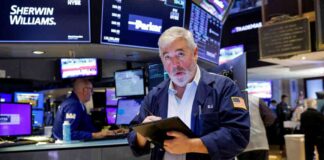Federal Reserve President Patrick Harker recently delivered a speech at Tulane University, where he discussed the Federal Reserve’s performance in managing the economy. While the current outlook was not explicitly mentioned, Harker touched on various key points that shed light on the Fed’s approach to monetary policy, job quality, research initiatives, decision-making processes, bank supervision, and the exploration of emerging technologies like artificial intelligence (AI) and quantum computing.
Monetary Policy as Driving a Bus
Harker likened the Fed’s role in implementing monetary policy to driving a bus, emphasizing the need to strike a balance between speed and caution. Just as a bus driver must navigate various road conditions to reach their destination safely and efficiently, the Federal Reserve must consider a multitude of factors when making decisions about interest rates, inflation targets, and economic growth. Harker highlighted the importance of maintaining stability while also being responsive to changing economic conditions, much like adjusting the speed of a bus to ensure a smooth ride for passengers.
By drawing parallels between monetary policy and driving a bus, Harker underscored the delicate nature of the Fed’s responsibilities in steering the economy towards sustainable growth and stability. This analogy serves as a reminder that effective monetary policy requires foresight, adaptability, and a steady hand at the wheel to navigate the twists and turns of economic cycles.
Maximizing Employment Quality
In his speech, Harker emphasized that achieving maximum employment involves not only creating jobs but also ensuring the quality of those jobs. Simply focusing on quantity without considering the nature of employment opportunities can lead to disparities in income, job security, and overall economic well-being. Harker’s remarks underscore the importance of promoting job growth in sectors that offer fair wages, benefits, and opportunities for advancement, rather than merely increasing the total number of jobs available.
By highlighting the significance of job quality in the context of maximum employment, Harker brings attention to the broader implications of labor market dynamics on economic inequality, social mobility, and overall prosperity. This perspective underscores the Federal Reserve’s commitment to fostering a labor force that is not only robust in numbers but also resilient in terms of job satisfaction, stability, and upward mobility.
Research and Decision-Making
Beyond its traditional role in monetary policy, the Philadelphia Fed conducts research that goes beyond the realm of interest rates and inflation targets. Harker emphasized the importance of both “hard” and “soft” data in informing decision-making processes, recognizing that economic indicators alone may not capture the full complexity of real-world trends and challenges. By incorporating a diverse range of research methodologies and data sources, the Fed can enhance its analytical capabilities and make more informed policy choices.
Harker’s emphasis on research and data-driven decision-making reflects the Federal Reserve’s commitment to evidence-based policymaking and empirical analysis. By leveraging a mix of quantitative and qualitative data, the Fed can better understand the underlying dynamics of the economy, anticipate potential risks, and tailor its policy responses to address specific challenges. This research-oriented approach underscores the Fed’s dedication to fostering a culture of continuous learning, innovation, and adaptability in the face of a rapidly evolving economic landscape.
In addition to its research endeavors, the Federal Reserve plays a crucial role in bank supervision and ensuring financial stability. By overseeing the operations of financial institutions, monitoring systemic risks, and implementing regulatory safeguards, the Fed helps safeguard the integrity of the banking system and protect against potential threats to the overall economy. Harker’s remarks underscore the importance of vigilant supervision and proactive risk management in maintaining a resilient and secure financial sector.
Furthermore, the Federal Reserve is exploring the potential impacts of artificial intelligence (AI) and quantum computing on finance. As technological advancements continue to reshape the financial industry, the Fed is actively exploring how AI algorithms, machine learning models, and quantum computing capabilities could enhance decision-making processes, optimize risk management strategies, and improve the efficiency of financial operations. Harker’s mention of these emerging technologies highlights the Fed’s proactive stance towards innovation and its commitment to leveraging cutting-edge tools to navigate the complexities of the modern financial landscape.
In conclusion, Patrick Harker’s speech at Tulane University offers valuable insights into the Federal Reserve’s approach to managing the economy, from monetary policy and job quality to research initiatives, decision-making processes, bank supervision, and technological innovation. By emphasizing the importance of balancing speed and caution in monetary policy, promoting job quality in addition to quantity, conducting rigorous research, and exploring AI and quantum computing applications, Harker underscores the Fed’s commitment to fostering a resilient, inclusive, and forward-looking economic environment.

















